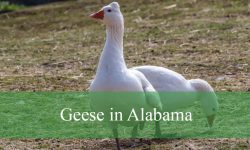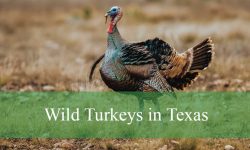If you enjoy watching birds flit through trees or gather at feeders, discovering the variety of finches in Michigan can be an exciting journey. These small, seed-loving birds are full of personality, with songs that brighten winter mornings and flashes of color that enliven summer gardens. Each species has its own charm, from the sunny American Goldfinch to the elusive Red Crossbill.
As a finch enthusiast, I’ve always found Michigan to be a great place for observing them across the seasons. In warmer months, gardens and meadows come alive with goldfinches and House Finches. When winter arrives, snow-covered feeders may attract rare visitors like Common Redpolls or even a Pine Grosbeak if you’re lucky.
This article highlights 12 fascinating finches in Michigan, complete with photos, identification tips, behavior, and where to find them. Exploring these birds opens up a new level of appreciation for the diverse avian life that calls Michigan home throughout the year.
Common Finches Found in Michigan
American Goldfinch (Spinus tristis)
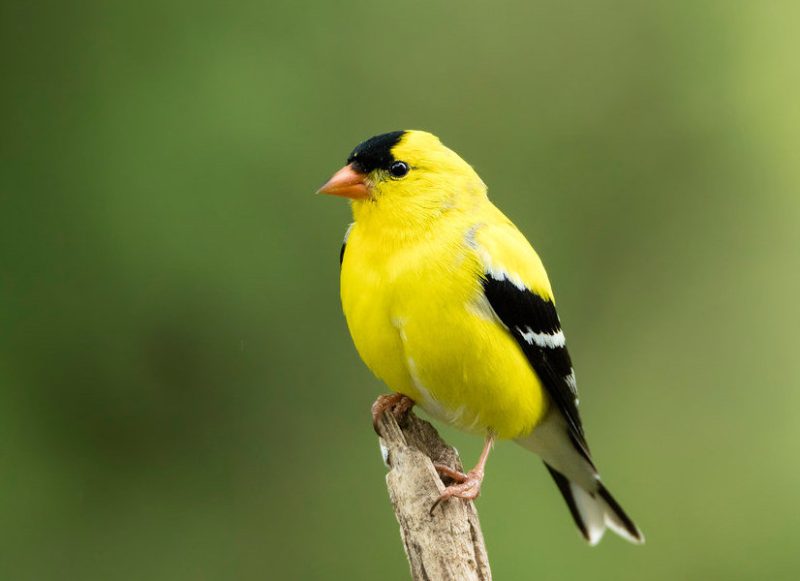
The American Goldfinch is a small, vibrant finch that undergoes a remarkable seasonal transformation. Males in summer boast bright lemon-yellow bodies with a contrasting black cap and wings, while females are duller yellow. In winter, both sexes take on a more muted olive-brown hue, blending easily into dormant landscapes. Measuring about 4.3 to 5.1 inches in length, this bird is easily recognized by its rollercoaster flight pattern and cheerful appearance.
Its song is a sweet, warbling series of twitters and whistles, often described as “po-ta-to-chip” in flight. The call is high-pitched and musical, frequently heard during active feeding and flying. American Goldfinches are known for their sociable nature and are commonly seen in flocks, especially outside of the breeding season. They are late nesters, often waiting until mid- to late summer when thistle plants are in full seed.
These finches primarily eat seeds, favoring sunflower, thistle (nyjer), and dandelion seeds. They are strict vegetarians and rarely consume insects. Their conical beaks are perfectly adapted for shelling small seeds. Bird feeders filled with nyjer seed will attract them year-round, especially in winter when natural food sources are limited.
In Michigan, American Goldfinches are found statewide and are one of the most common finch species. They frequent weedy fields, gardens, open woodlands, and suburban backyards. While present throughout the year, their activity noticeably increases in summer when their bright breeding plumage and frequent singing make them more visible and audible.
House Finch (Haemorhous mexicanus)
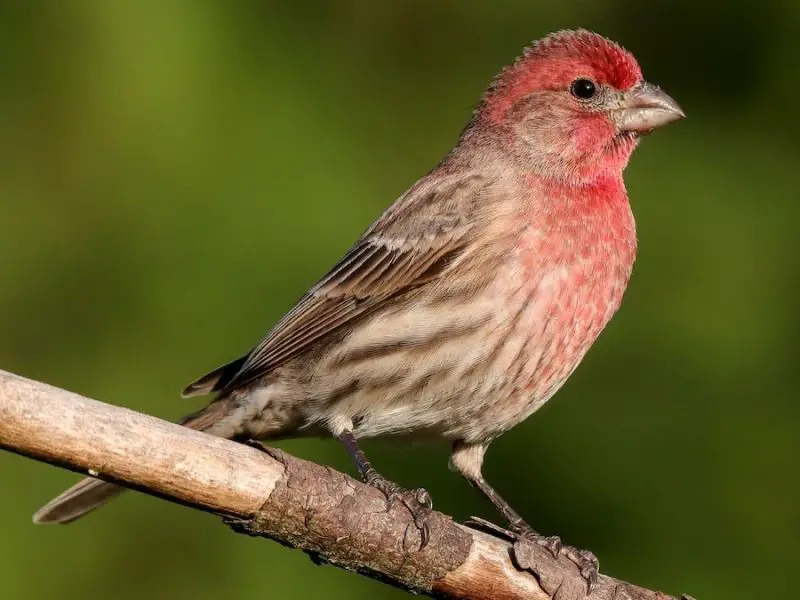
The House Finch is a medium-sized finch with a sturdy body and relatively long, flat head. Males display varying shades of red on the head, chest, and rump, with brown-streaked backs and bellies. Females, on the other hand, lack the red coloration and are overall streaky brown with a subtle face pattern. Both sexes have notched tails and curved bills, with lengths ranging from 5 to 6 inches.
Their song is a jumbled series of short notes and warbles, often ending in a distinctive rasp. Males sing from elevated perches to attract mates and defend territories. House Finches are highly adaptable and have adjusted well to human environments. Their behavior is bold and curious, and they’re often seen in small flocks or pairs, especially around feeders and birdbaths.
Diet consists mainly of seeds, grains, buds, and fruits, with sunflower seeds being a favorite at feeders. They also eat dandelions and occasionally insects. House Finches forage on the ground and in trees and are quick to exploit any new food source. During breeding, they often nest on building ledges or in hanging planters.
In Michigan, House Finches are year-round residents found across urban, suburban, and rural areas. They are particularly common in cities and towns, where they frequent backyard feeders and nesting boxes. Originally native to the western U.S., they have expanded eastward and are now a familiar sight throughout the state.
Purple Finch (Haemorhous purpureus)
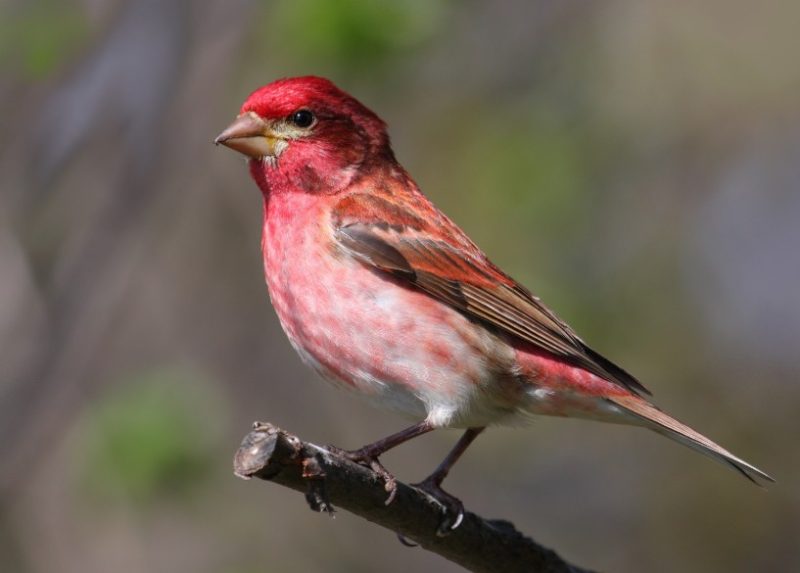
The Purple Finch is a striking bird, often described as a “sparrow dipped in raspberry juice.” Males exhibit a rich raspberry-red color on their head, chest, and back, blending into a lighter belly. Females are brown and heavily streaked with bold facial markings, including a white eyebrow stripe. Slightly chunkier than House Finches, Purple Finches measure about 4.7 to 6.3 inches in length.
Their song is a rich, melodious warble that sounds like a more refined version of the House Finch’s tune. Purple Finches sing frequently during spring and early summer, especially in forested areas. They are somewhat more reserved than House Finches and tend to forage quietly in trees rather than openly at feeders.
Purple Finches consume seeds, berries, and buds, with a special preference for sunflower seeds, maple buds, and fruit. They also eat insects during the breeding season. In winter, they often visit feeders and are especially fond of black oil sunflower seeds. Their strong, conical beaks help them crack open tough seed shells with ease.
In Michigan, Purple Finches are most commonly observed during migration and in winter months, particularly in the northern and central parts of the state. They inhabit coniferous and mixed forests but can also be found in suburban areas with ample tree cover. Their movements can be unpredictable, influenced by food availability and weather conditions.
Pine Siskin (Spinus pinus)
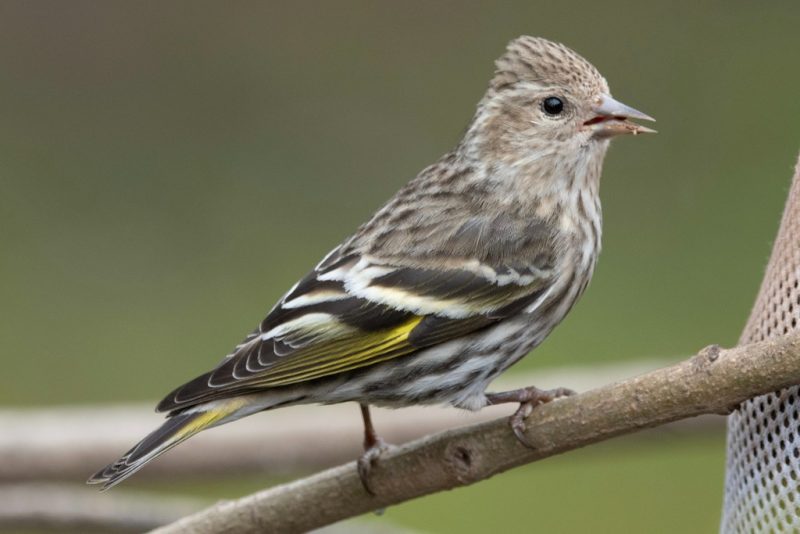
The Pine Siskin is a small, slender finch recognized by its streaky brown plumage and flashes of yellow on the wings and tail. Both sexes look similar and can be challenging to distinguish from other streaked finches. They measure around 4.3 to 5.5 inches in length, with a sharply pointed bill and notched tail that add to their delicate appearance.
Their vocalizations include a distinctive buzzy “zreeeeee” and chattering calls. Pine Siskins are energetic and often vocal, especially when feeding in groups. They are acrobatic foragers, hanging upside down from branches or feeders while picking at seeds. During irruption years, their numbers increase dramatically as they travel far beyond their typical range in search of food.
Their diet is composed mostly of seeds from conifers, alder, birch, and thistle. They are highly attracted to nyjer seed and will flock to feeders offering it. Unlike other finches, Pine Siskins occasionally eat insects and spiders. In winter, they rely heavily on feeders when natural seed supplies are low.
In Michigan, Pine Siskins are considered irregular winter visitors. Their presence varies from year to year depending on food availability in their boreal forest breeding grounds. When they do appear, they are found across the state, especially at feeders in both urban and rural settings. They also visit wooded parks and open forests, particularly in northern Michigan.
Common Redpoll (Acanthis flammea)
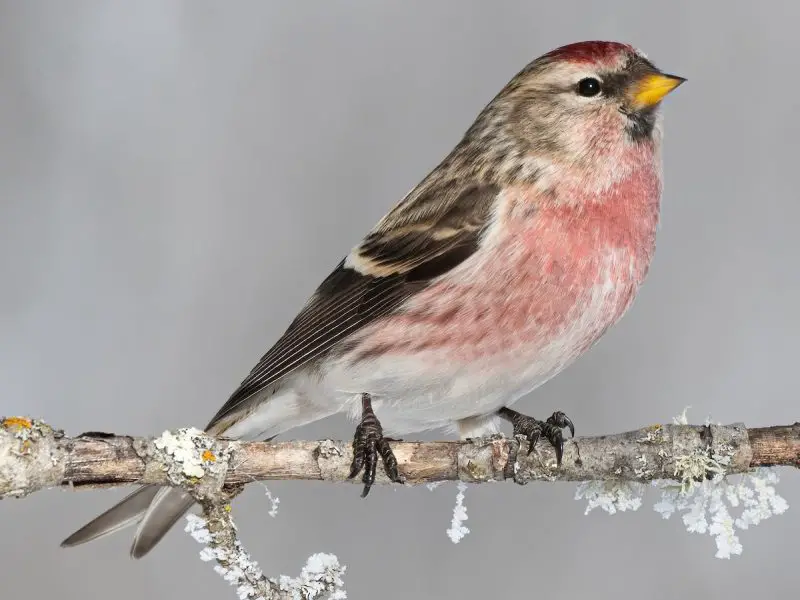
The Common Redpoll is a petite, energetic finch easily recognized by its bright red forehead and contrasting black chin. Both sexes have streaked brown and white plumage, but males often show a soft pink blush on the chest during the breeding season. These birds are about 4.7 to 5.5 inches long, with a small, conical yellow bill that helps them crack tiny seeds even in freezing conditions.
Their song is a rising, buzzy trill mixed with short twittering calls. Common Redpolls are social and vocal, often traveling in flocks that chatter constantly while feeding. They are lively and acrobatic, sometimes hanging upside down from seed heads or feeders. Their flight is bouncy and undulating, typical of many small finches.
Redpolls feed heavily on small seeds, particularly birch, alder, and willow catkins, as well as weed seeds and thistle. In winter, they frequent feeders stocked with nyjer and sunflower chips. Unusually for songbirds, they can survive extreme cold thanks to their dense plumage and ability to store seeds in an internal pouch, which they eat later while roosting.
In Michigan, Common Redpolls are most often observed during the winter months. They are especially abundant in the Upper Peninsula and northern Lower Peninsula but can also appear farther south during major irruption years. Their presence varies annually depending on food supplies in their Arctic breeding grounds.
Evening Grosbeak (Coccothraustes vespertinus)

The Evening Grosbeak is a large, robust finch with a striking appearance and powerful bill. Adult males display vivid yellow bodies, black wings with white patches, and a thick pale bill. Females are more subdued, with grayish bodies, greenish-yellow tints, and white-edged wings. They range from 6.3 to 8.7 inches long, making them one of the largest finches in North America.
Their vocalizations are sharp, clear whistles that often sound like short “cleer” notes, along with varied trills and chirps. Though not known for elaborate songs, their distinctive calls are loud and carry well through coniferous forests. These finches often gather in flocks and can appear suddenly at feeders in large numbers during winter.
Evening Grosbeaks primarily eat seeds, buds, berries, and tree sap, with a strong preference for maple seeds and sunflower seeds at feeders. Their massive beaks enable them to crack open large seeds and even cherry pits. During the breeding season, they may also consume some insects and caterpillars.
In Michigan, the Evening Grosbeak is an irregular winter visitor, most commonly seen in the Upper Peninsula and northern forests. They are unpredictable in appearance, arriving in greater numbers during irruption years when food sources to the north are scarce. Birdwatchers in northern Michigan sometimes spot them at feeders during snowy months.
Red Crossbill (Loxia curvirostra)
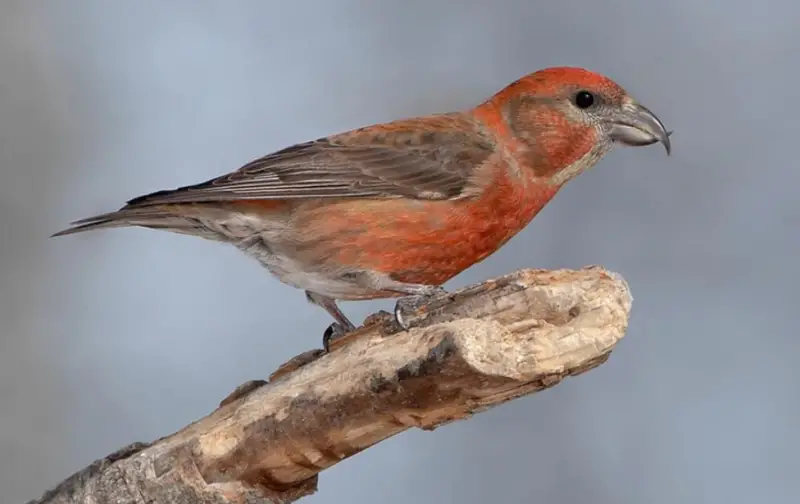
The Red Crossbill is a unique finch known for its specialized bill, where the upper and lower mandibles cross at the tips. This adaptation allows it to extract seeds from tightly closed conifer cones. Males are brick-red or orange, while females are olive or yellowish-green. They measure about 5.5 to 6.7 inches in length, with a chunky body and notched tail.
Their song is a jumble of musical warbles and chips, while their flight call—a sharp, metallic “kip-kip”—is often the best way to identify them. Red Crossbills are nomadic and can be seen flying high over forests in tight flocks. Their breeding cycle is highly flexible and can occur whenever conifer seed crops are abundant, even in winter.
Red Crossbills feed almost exclusively on the seeds of conifers such as pine, spruce, and hemlock. They use their crossed bills to pry open cones and extract the seeds inside. At times, they may also eat buds, berries, and occasional insects, but their diet remains heavily dependent on conifer seeds year-round.
In Michigan, Red Crossbills are occasional visitors, primarily found in the northern parts of the Lower Peninsula and the Upper Peninsula. They favor mature pine forests and are most likely to be seen during winter months when cone crops attract them southward. Sightings vary from year to year, depending on regional food availability.
White-winged Crossbill (Loxia leucoptera)
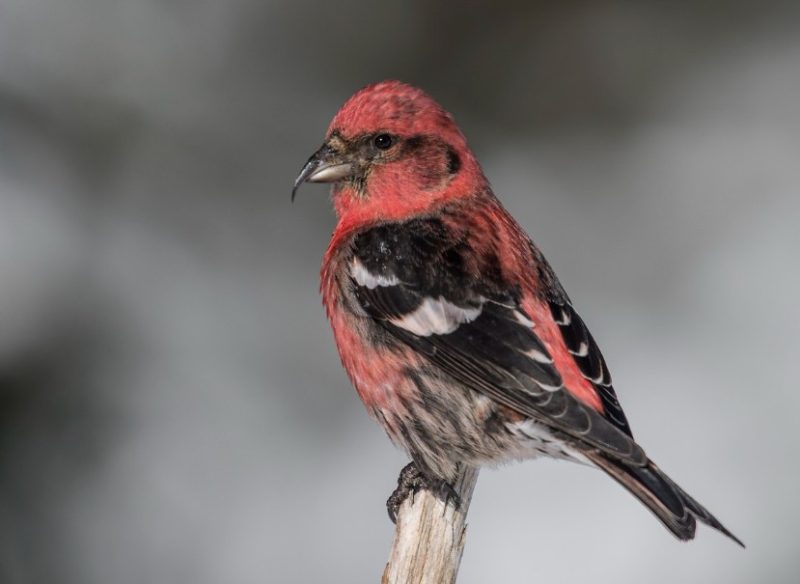
The White-winged Crossbill is another specialist finch with crossed mandibles, but it’s easily distinguished from the Red Crossbill by its prominent white wing bars. Males have rosy-pink bodies with black wings and tails, while females are yellow-green with similar white wing markings. They are medium-sized finches, measuring 5.9 to 6.7 inches in length.
Their song is a series of trills and sweet, warbling phrases, while their call is a distinctive “chet-chet” that echoes through conifer forests. White-winged Crossbills are active and often seen clambering on spruce cones or flying in tight flocks. They are nomadic and unpredictable, sometimes appearing in large numbers when cone crops are heavy.
These birds feed almost entirely on seeds from spruce and tamarack cones, prying them open with their specialized beaks. They may supplement their diet with weed seeds or small insects during warmer months. Their feeding behavior is efficient and often continuous, even in cold conditions, as they rely on high-energy seeds for survival.
In Michigan, White-winged Crossbills are more commonly found in the Upper Peninsula and the northernmost coniferous forests of the Lower Peninsula. They are considered irruptive species, meaning their numbers and locations fluctuate widely depending on food availability. Winter is the best time to spot them, particularly in spruce-dominated habitats.
Hoary Redpoll (Acanthis hornemanni)

The Hoary Redpoll is a small, pale finch that closely resembles the Common Redpoll but is lighter overall, with a frosty white appearance. It features a red forehead, black chin, and faint streaking on the flanks. The body is mostly white with a grayish back, and adult males may show a subtle pink wash on the chest. It ranges in size from 4.7 to 5.5 inches, with a short tail and stubby yellow bill.
Its vocalizations are nearly identical to the Common Redpoll’s—sharp, rising “chit-chit” calls and buzzy trills. Because the two species often flock together, spotting a Hoary Redpoll requires careful observation of plumage. This species is calm and sociable, usually blending into winter flocks that forage actively among trees or snow-covered fields.
Hoary Redpolls eat seeds from birch, alder, and weeds. Like their relatives, they also enjoy nyjer seed and sunflower chips at feeders. These birds are well adapted to the cold and can store seeds in their throat pouches to consume later when roosting.
In Michigan, the Hoary Redpoll is a rare winter visitor, usually seen only during especially harsh winters. It is sometimes found mixed with large flocks of Common Redpolls in the northern regions of the state, especially in the Upper Peninsula. Confirmed sightings often come from experienced birders familiar with subtle plumage differences.
Lesser Goldfinch (Spinus psaltria)
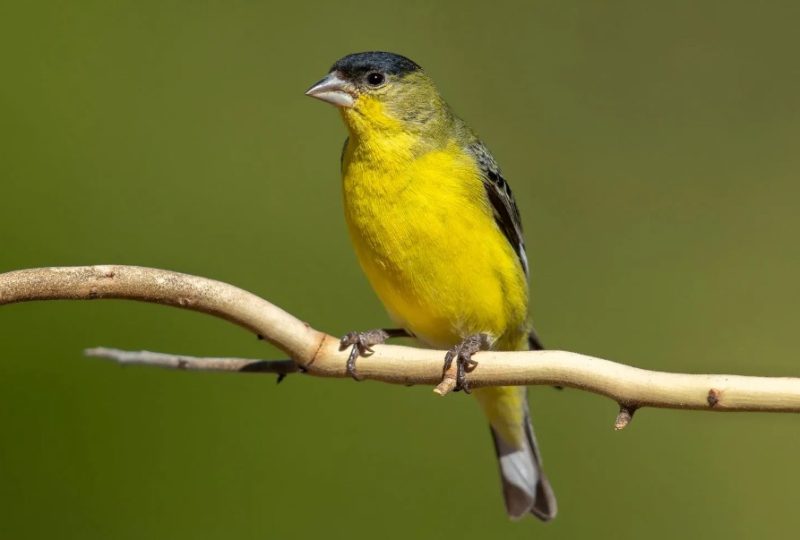
The Lesser Goldfinch is a small, brightly colored finch most commonly found in the western United States. Adult males have glossy black or dark greenish-black backs, bright yellow underparts, and white wing patches. Females are duller, with olive backs and less vibrant yellow bellies. This species is tiny, measuring just 3.5 to 4.3 inches in length.
Its song is an energetic mix of high-pitched trills, warbles, and mimicry of other birds. Lesser Goldfinches are highly vocal and often sing even while flying. They are social, forming small flocks that move through open woodlands, gardens, and brushy areas. Their flight is bouncy and quick, typical of goldfinches.
These finches feed on seeds, especially sunflower and thistle, as well as buds, fruits, and occasionally insects. Their conical beaks are perfect for extracting small seeds from flower heads or feeder trays. They are frequent visitors to backyard feeders in their native range.
In Michigan, the Lesser Goldfinch is extremely rare and considered a vagrant species. Only a few isolated individuals have been documented, usually in the southern part of the state during migration seasons. These out-of-range birds are typically detected by keen birdwatchers and are not expected on a regular basis.
Gray-crowned Rosy-Finch (Leucosticte tephrocotis)
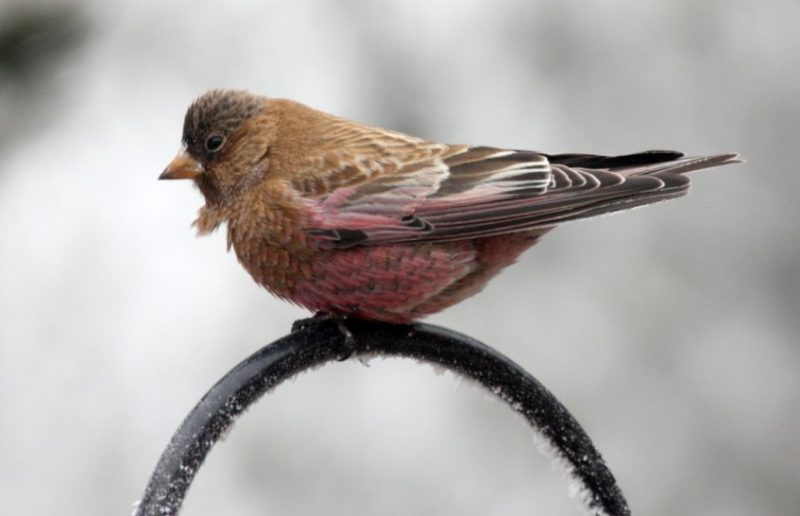
The Gray-crowned Rosy-Finch is a large, cold-hardy finch with a distinctive blend of dark brown, pink, and gray. Adults are brownish with a rosy-pink wash on the belly and wings and a contrasting gray crown. They are about 5.5 to 8.3 inches in length and appear bulky with a thick neck and stout beak, built for life in harsh alpine climates.
Their calls are dry, buzzy notes and sharp “chew” or “zheep” sounds, often heard as they fly in tight flocks. Rosy-Finches are known for their elusive, high-altitude habits. They forage in groups, often on snowy ground, and are seen flying low over rocky terrain or perching briefly on exposed shrubs.
They feed on weed seeds, grasses, and insects, often scratching through snow to find food. During winter, they will also consume grains and berries, occasionally visiting feeders near mountain lodges or remote cabins. Their diet supports survival in the windswept, snow-covered regions they inhabit.
In Michigan, the Gray-crowned Rosy-Finch is a true rarity, with only a few confirmed sightings in history. These records are typically from winter, and most occur after extreme weather events. If found at all, they are most likely to appear in the Upper Peninsula, though even there, sightings are exceptionally uncommon.
Pine Grosbeak (Pinicola enucleator)
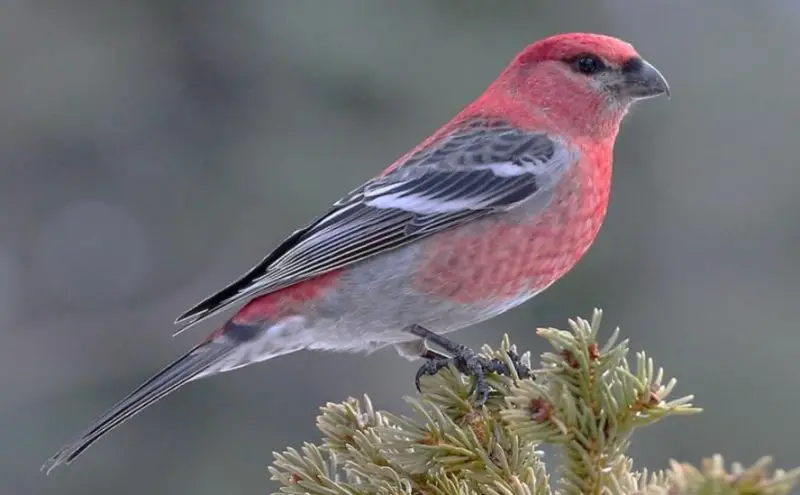
The Pine Grosbeak is a large, gentle finch-like bird from the boreal forests of North America. Males are rosy-red on the head, chest, and back, while females are mostly gray with golden or rust-colored highlights. Both sexes have heavy, stubby bills and black wings with white wing bars. They measure between 7.9 to 10 inches long, making them one of the largest finch relatives.
Their vocalizations are soft, flute-like whistles and sweet warbles, often described as mournful or dreamy. Pine Grosbeaks are relatively quiet and slow-moving, usually found in small, loose flocks. They are tame and approachable, often foraging at low heights or even on the ground without fear of humans.
They primarily eat berries, buds, seeds, and insects. During winter, they feed heavily on mountain ash, crabapple, and other fruit-bearing trees. Unlike other finches, they often swallow fruit whole. Their calm behavior and reliance on berries make them easy to observe near ornamental trees or shrubby forest edges.
In Michigan, Pine Grosbeaks are rare winter visitors, usually seen only in the Upper Peninsula and northern forests. They are most frequently encountered during irruption years when food sources are scarce in their usual Canadian range. Look for them near berry trees in quiet, wooded areas from late fall through early spring.
FAQ About Finches in Michigan
What types of finches can be found in Michigan?
Michigan is home to several species of finches throughout the year. Common residents and seasonal visitors include the American Goldfinch, House Finch, Purple Finch, and Pine Siskin. During winter months, you may also see irruptive species like the Common Redpoll, Hoary Redpoll, Evening Grosbeak, Red Crossbill, and White-winged Crossbill. Rare vagrant species such as the Lesser Goldfinch, Gray-crowned Rosy-Finch, and Pine Grosbeak have occasionally been spotted as well.
Are finches present year-round in Michigan?
Yes, some finch species are year-round residents in Michigan, such as the American Goldfinch and House Finch. Others, like the Purple Finch and Pine Siskin, may be more common in certain seasons, particularly during migration or winter. Species like Common Redpolls, Red Crossbills, and Evening Grosbeaks typically appear only in winter, especially in northern parts of the state.
Where can I see finches in Michigan?
Finches in Michigan can be seen in a variety of habitats. American Goldfinches and House Finches are common in gardens, fields, and suburban areas, especially at feeders. Forested regions in northern Michigan, especially the Upper Peninsula, are good places to observe irruptive and conifer-dependent finches like Red and White-winged Crossbills. Rare species may appear unpredictably during harsh winters or food shortages.
What do Michigan finches eat?
Most finches eat seeds, with a preference for sunflower seeds, thistle (nyjer), and conifer seeds depending on the species. Some, like the American Goldfinch, are strict seed eaters, while others, like the Pine Grosbeak or Purple Finch, also consume fruit, buds, and occasional insects. Many species visit bird feeders, especially in winter when natural food sources are limited.
How can I attract finches to my backyard in Michigan?
To attract finches, provide feeders filled with nyjer (thistle) or black oil sunflower seeds. Hanging feeders and tube feeders work well. Planting native flowers such as coneflowers, sunflowers, and dandelions can also help, as can leaving seed-bearing plants standing into winter. Providing a water source, especially in colder months, also increases your chances of attracting finches.
What’s the difference between a House Finch and a Purple Finch?
House Finches are slightly smaller with more streaked plumage, and the males have a bright red wash on the head and chest. Purple Finch males appear more raspberry-red all over, with less streaking and a more bulky build. Female Purple Finches have bold facial markings, unlike the more uniformly streaky female House Finches. The two species also prefer slightly different habitats and food sources.
Do finches migrate in Michigan?
Some finch species in Michigan are migratory, while others are resident. American Goldfinches remain in the state year-round but change plumage in winter. Pine Siskins, Purple Finches, and Redpolls are partial migrants, moving south in varying numbers depending on food availability. Crossbills and grosbeaks may migrate short distances or shift locations during irruptive years.
Are Hoary Redpolls and Common Redpolls the same?
No, they are different species but very similar in appearance. Hoary Redpolls are paler and frostier-looking with less streaking on the sides and a smaller bill. They are much rarer in Michigan and usually appear mixed within flocks of Common Redpolls during particularly cold winters. Careful observation is needed to distinguish the two.
Why do some finches only appear in winter?
Several finch species, such as Evening Grosbeaks, Red Crossbills, and Common Redpolls, breed far to the north in Canada and Alaska. In winters when food sources like conifer seeds or birch catkins are scarce, these birds migrate south into the Great Lakes region, including Michigan. These movements, called irruptions, are unpredictable and vary from year to year.
What is the best time of year to watch finches in Michigan?
Finches can be seen in Michigan all year, but the best times vary by species. Summer is great for spotting colorful American Goldfinches and breeding House Finches. Winter is the best time to look for rarer species like Redpolls, Crossbills, and Grosbeaks, especially in the northern parts of the state or near feeders stocked with seeds.


